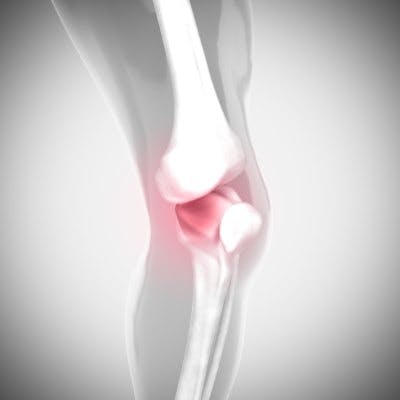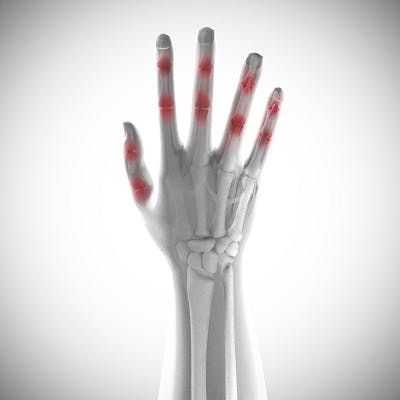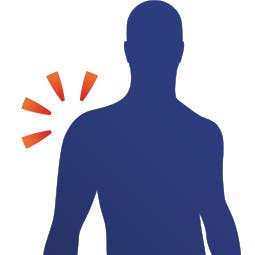There are many reasons why we can experience aches and pains in our joints, and one possible cause is arthritis.¹ ² Arthritis is the medical term for inflammation within your joints³, and there are different types, which include: osteoarthritis (the most common type of arthritis) and rheumatoid arthritis.⁴ This article will help you to understand a bit more about these two conditions, and what you can do if you are affected.
Osteoarthritis (OA) is the most common type of arthritis and is one of the leading causes of pain worldwide.⁴ A degenerative disease limited to the joints, the pain usually appears in people over 45 years old and it tends to affect the knees, hips and small joints of the hands.⁴ ⁵ Non-serious OA pain can be self-managed with non-prescription drugs, but it requires to be diagnosed by a healthcare professional and often requires ongoing guidance.
Causes
In osteoarthritis, the cartilage that acts as a protective cover over the ends of the bones in a joint and helps them to move smoothly, breaks down.⁷ The bone underneath gets thicker and inflamed too.² These changes can make it difficult for you to move your joint as easily as you could before.²
There are two types of osteoarthritis: primary and secondary.⁵

Doctors don’t know exactly why primary osteoarthritis happens.⁵ There isn’t an obvious, or identified, cause.⁵
Secondary osteoarthritis has precipitating factors.⁵ You might be more likely to get osteoarthritis if:² ⁴
- You’re over 45
- You’ve injured your joint before
- Your occupation, or activities put your joint under a lot of stress – you may overuse a joint, or joints
- You’re a woman – women tend to get osteoarthritis a bit more than men
- You have a family history of osteoarthritis
- You’re obese
- You were born with problems with your joints – an example is congenital hip dysplasia, where the ball and socket joint of the hips doesn't work properly⁵
- Your joint doesn’t sit in the normal position – it’s misaligned
- You have a high bone density
- You have less strength in your muscles than normal
- You have loose ligaments in your joints
Rheumatoid arthritis is what’s called an autoimmune disease – your body’s own immune system starts to attack and damage your joints and the surrounding tissues.⁸ This causes inflammation, pain, and swelling in the joints and it may even damage them over time.⁹
The exact reason why this happens isn’t known but if anyone in your family has rheumatoid arthritis, you’re more likely to get it. More women than men get rheumatoid arthritis, and if you smoke or are very overweight, this can increase your risk too.⁹
Symptoms

Osteoarthritis symptoms include:²
- pain and stiffness in and around your joints or in surrounding areas – this is often worse after exercise, and it gets better if you rest
- a restricted range of movement in your joint
- swelling in the joint – the area might feel warm
- a crunching and grinding feeling and noise in your joint when you move it
- bony swellings in your fingers (if they’re affected)
- your joint giving way when you put weight on it – this might happen if the surrounding muscles are weak or if your joint becomes unstable

Rheumatoid arthritis symptoms include:⁹
- pain and stiffness in your joints – this is usually worse first thing in the morning, or if you get up after not moving for a while
- swollen joints
With rheumatoid arthritis, you might also:⁹
- Get problems with your hands where the bones don’t lie normally so can bend and look out of shape
- Feel exhausted
- Get fevers
- Feel generally unwell
A course of physiotherapy will give you a more structured exercise plan to follow to help you stay flexible and build up your muscle strength.² All of which, will help your joint to stay stable and strong.
To help with the pain of osteoarthritis, over-the-counter pain relieving gels (topical medicines) that contain non-steroidal anti-inflammatory drugs (NSAIDs) should help.⁴ Topical anti-inflammatories are recommended as one of the first line pharmacological treatments to relieve pain in osteoarthritis.⁴
There are plenty of treatments to help you keep moving so you can enjoy your life to the full. For more information about how to improve the symptoms of osteoarthritis, take a look at the separate article How to alleviate osteoarthritis or speak to your healthcare professional.
Rheumatoid arthritis treatments include the following.⁸ ¹¹
- Physiotherapy. This will help you to stay flexible and build up your muscle strength.
- Over-the-counter painkillers. Paracetamol or nonsteroidal anti-inflammatory drugs (NSAIDs) such as ibuprofen may help to ease pain and stiffness in your joints. You can use them as ‘rescue medication’ in case you run out of your prescribed treatment and don’t have quick access to refill them. But make sure you obtain your prescribed treatment as soon as possible.
- Disease-modifying antirheumatic drugs (DMARDs). These work on your immune system to reduce the attack on your joints.
- Steroid medicines. These may help to control pain and stiffness in your joints. If you have a severely painful and swollen joint, you might need to have a steroid injection into it.
- Biological medicines. These target chemicals in your body that cause inflammation and mimic substances produced by your own body, such as antibodies.
- Surgery. If other treatments haven’t worked, you may need an operation to replace part, or all of your joint with an artificial one.
Getting a diagnosis
It’s important to seek medical help if you have pain in your joints. Treatment for rheumatoid arthritis will work better the earlier you start.⁶
Make an appointment to see your GP. If they suspect you might have osteoarthritis or rheumatoid arthritis, they’ll refer you for tests or to see a specialist doctor called a rheumatologist.¹¹
There isn’t a single test for osteoarthritis or rheumatoid arthritis – your doctor should be able to diagnose you by asking about your symptoms and examining you.⁹
It’s a good idea to be prepared before you see your doctor and to note down things like when you have the pain and how long it lasts – you could record this in a diary or your phone.⁴ ¹²
For more information about how osteoarthritis is diagnosed and treated, check out the separate article Explaining osteoarthritis.
*This information is for educational purposes only and is by no means intended to promote the use of non-prescription products. However if non-prescription products are used, such use must always be in line with the approved indications.
References
¹ The approach to the painful joint. Medscape. https://emedicine.medscape.com/article/336054-overview#showall, accessed May 2018
² Osteoarthritis. Patient.Co.Uk Professional Reference. https://patient.info/doctor/osteoarthritis-pro, accessed May 2018
³ Pain in and around a single joint. MSD Manual Professional Version. https://www.msdmanuals.com/professional/ musculoskeletal-and-connective-tissue-disorders/pain-in-and-around-joints/pain-in-and-around-a-single-joint, accessed May 2018
⁴ Osteoarthritis care and management. National Institute for Health and Care Excellence (NICE). https://www.nice.org.uk/guidance/cg177, accessed May 2018
⁵ Osteoarthritis. Medscape. https://emedicine.medscape.com/article/330487-overview#showall, accessed May 2018
⁶ Rheumatoid arthritis in adults: Management National Institute for Health and Care Excellence (NICE). https://www.nice.org.uk/guidance/cg79/resources/ rheumatoid-arthritis-in-adults-management-pdf-975636823525, accessed May 2018
⁷ Osteoarthritis. NICE Clinical Knowledge Summaries. https://cks.nice.org.uk/osteoarthritis# !topicsummary, accessed May 2018
⁸ Rheumatoid arthritis. NICE Clinical Knowledge Summaries. https://cks.nice.org.uk/rheumatoid-arthritis#!topicsummary, accessed May 2018
⁹ Rheumatoid arthritis Patient.Co.Uk Professional Reference. https://patient.info/doctor/rheumatoid-arthritis-pro, accessed May 2018
¹⁰ Osteoarthritis treatment & management. Medscape. https://emedicine.medscape.com/article/330487-treatment#showall, accessed May 2018
¹¹ Management of rheumatoid arthritis Patient.Co.Uk Professional Reference. https://patient.info/doctor/management-of-rheumatoid-arthritis, accessed May 2018
¹² What are the symptoms of arthritis? Arthritis Research UK. https://www.arthritisresearchuk.org/arthritis-information/conditions/arthritis/symptoms.aspx, accessed May 2018
Learn more
All you need to know about pain relief
Here we explain how different types of pain relief products work, to help you choose the best one for your pain.
read moreWhat is inflammation?
Learn all about the processes that cause inflammation, why it happens and how it can make our bodies feel.
*Haleon Global Pain Index Research 2014, report, p.40
read more













